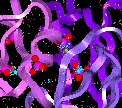 Ewald Sums
Ewald Sums Ewald Sums
Ewald SumsFigure 2-10 depicts the electrostatic energy for quartz as computed by various techniques supported by the Discover program. If life were simple, all the techniques would converge to the same value at high cutoff distances. Note, however, that the direct atom-based approach yields results that fluctuate wildly as the cutoff increases, even for rather large cutoffs. The problem is that the sum is only conditionally convergent. As the cutoff increases, charges of opposite sign are taken into account and the partial sum is modified significantly. Worse, reordering the terms of a conditionally convergent series can yield arbitrary results. The trick then is to find physically and chemically meaningful orderings of the series. The cell-based and group-based techniques provided by the Discover program are natural candidates. Unfortunately, as Figure 2-10 indicates, they yield somewhat different values. This is due to the different cutoff conventions employed. The group-based technique computes the result for a sphere, while the cell-based technique computes the result for a parallelepiped that preserves the shape of the unit cell. A standard Ewald calculation that does not take the dipole moment of the unit cell into account yields yet another value. Fortunately, an Ewald calculation that includes the effect of the dipole moment agrees with the group-based calculation.
For van der Waals energy, the energy sum is absolutely convergent, and no chaotic behavior arises from the direct approach. Even so, as Figure 2-11 indicates, the convergence of the dispersive energy is slower than might be expected. Even with a cutoff distance of 30 Å, the error is a significant fraction of 0.1 kcal mol-1. (Note that the Ewald calculation is less costly for comparable accuracy.) The repulsive energy, on the other hand, converges at a cutoff distance of only 15 Å and needs no special treatment. (Atom-based calculations for much larger systems, however, show that sometimes even the repulsive error can exhibit a surprisingly high error at a cutoff of 12 Å.)
The convergence functions used by the Discover program are, for the electrostatic energy:
The Ewald energy expression for the electrostatic energy is:
In Eq. 2-14, the first term corresponds to the real-space sum, and the second term corresponds to the reciprocal-space sum. The similarity between the Ewald real-space sums and the full real-space sums facilitates the use of existing Discover nonbond machinery for Ewald calculations. The last term in Eq. 2-14 arises from the exclusion of the i = j terms when L = 0, since the reciprocal space sum includes these terms. The third term in Eq. 2-14 corresponds to h = 0 in the second term, while the fourth term is from exclusion of the i = j terms when L = 0. Note that the reciprocal-space term of Eq. 2-14 involves a summation over i and j. If the geometric combination rule -Bij = sqrt(Bii Bjj ) holds, then the sum over i and j can be reduced to an analogous sum over i. This provides a substantial performance improvement (N 1.5 instead of N 2.5, where N is the number of atoms per unit cell).
Most implementations of the electrostatic Ewald drop the h = 0 term in the sum over h in Eq. 2-14. At first glance it appears to be 0 because of the neutrality of the unit cell. More careful inspection reveals that it is not always 0, and its value depends upon how limits are taken (Deem et al. 1990). Thus, the Discover 95.0 program assumes a spherical cutoff, to include a correction for this term.
 Main
access page
Main
access page  Theory/Methodology access.
Theory/Methodology access.
 Describe-System access
Describe-System access
 Cell Multipole Method
Cell Multipole Method
 Constraints and Restraints
Constraints and Restraints
Copyright Biosym/MSI